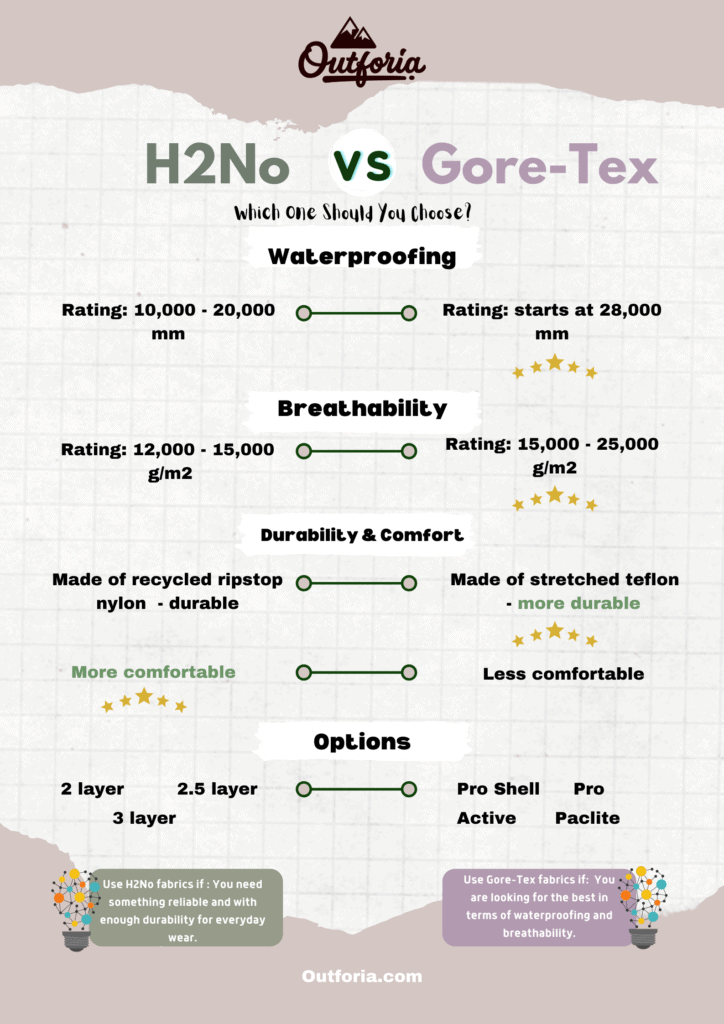For outdoor enthusiasts, being prepared for any weather patterns that Mother Nature throws at you is essential. What you need is a waterproof material that protects you and your belongings throughout your time outdoors.
H2No and Gore-Tex are some of the most popular solutions to this industry-wide problem. This article tackles the answer to which one is better than the other in most situations, H2No vs. Gore-Tex. These two materials are excellent choices when looking for an outer clothing layer for your outdoor trips.
When comparing H2No vs. Gore-Tex, understand that both materials are of the highest quality in the industry. However, Gore-Tex fabrics are still consistently more waterproof, breathable, and durable than H2No materials. H2No outstrips Gore-Tex fabrics only in being more comfortable since Gore-Tex tends to be quite stiff. H2No also receives a longer-lasting DWR treatment than Gore-Tex materials.

H2No® Fabrics
H2No fabric standard is a benchmark used by an outdoor company called Patagonia. Most people interested in outdoor-related products, particularly clothes, will be well-acquainted with this company. Ever since their establishment in 1973 by Yvon Chouinard, they have provided high-quality clothing whose manufacturing follows sustainable practices.
Quality is a big deal to this company, and that is where the H2No fabric standard comes in. They have constructed various tests and investigations to ascertain that the fabric reaches the highest possible standard of waterproofness and is breathable and durable.
They have set the standard for the H2No fabric by putting each piece through highly controlled tests. All of these simulate the use that these garments get in the real world. They mimic Mother Nature by simulating periods of both prolonged and light rain. They test breathability through a measurement of the material’s Moisture Vapor Transmission Rate (MVTR).
Finally, they use a Killer Wash both during construction and after finalizing the product. This wash simulates drenching conditions in which the fabric would be subject to abrasion, similar to many years of use.
Tech Specs
- Various fabrics have waterproof ratings between 10,000 to 20,000 mm range
- Receives long-lasting Deluge® DWR treatment
- Breathability rating of 12,000 to 15,000 g/m2/24h
- Comfort fabric technology gets woven into many finished products
Pros
- H2No fabric far exceeds minimum waterproof ratings
- DWR treatment from Patagonia is more durable and requires fewer re-treatments
- Fabric is both comfortable and usable
- Breathability keeps it functional for many hardcore sports
Cons
- Patagonia gear is often on the high-end of the budget spectrum
- Breathability is not as high as many other similar products
Gore-Tex® Fabrics
Gore-Tex® fabrics have long been the best in the industry. They are a fabric membrane that belongs as a trademarked product to W. L. Gore and Associates. Initially invented in 1969, the name became the moniker for the products of the company.
The surge in this fabric’s waterproof capacity came about when the founder’s son invented expanded polytetrafluoroethylene or ePTFE. The success of ePTFE incorporated into Gore-Tex® fabrics was huge. It is mostly due to the characteristics of the company’s products. It is highly durable, with PTFE being better known as Teflon. Overall, it has a minimal capacity to absorb water.
Another significant focus of the company is the construction, with billions of micropores gathered on its surface of the material. These are what give it its increased breathability. The tightness of the fabric makes it windproof as well.
The downside of the ePTFE is that it makes the fabric quite stiff, and therefore less comfortable. There are several varieties of the material, though, if you want a product more focused on comfort.
Tech Specs
- Waterproof ratings start at 28,000 mm
- DWR coating on the exterior
- Breathability rating of 15,000 to 25,000 g/m2/24h
- ePTFE membrane extremely abrasion-resistant
Pros
- ePTFE membrane exceeds durability tests of all kinds
- Very high waterproof rating
- High breathability rating and moisture-wicking capacity
- Multiple fabric choices for lighter or heavier options
Cons
- DWR coating is not as durable as other company’s
- The ePTFE coating makes the material quite stiff
Features Face-to-Face
When you compare H2No vs. Gore-Tex® fabric technology, you need to remember that each excels in some ways that the other might not. Depending on how you want to use it, the final winner might be different for you.
However, there is a winner in the end when examining their features and technical specs objectively. Essential aspects of an outdoor material are its level of waterproofness, durability, breathability, and the personal comfort of the fabric.

Share This Image On Your Site
<a href="https://outforia.com/h2no-vs-gore-text/"><img style="width:100%;" src="https://outforia.com/wp-content/uploads/2020/11/H2No-vs-GoreTex-2-724x1024.png"></a><br> H2NO vs Gore tex Infographic by <a href="https://outforia.com">Outforia</a>Rating of Waterproofness
For a material to gain the consideration and be a waterproof fabric, it has to have at least a 1,000 mm rating. This rating signifies the amount of water pressure that a material can hold up against before it begins to press through it.
Both the H2No and the Gore-Tex® materials surpass this, but Gore-Tex® has taken the cake on this one by maintaining the highest minimum score for those fabrics in the industry.
H2No fabrics are varied, so they do not always receive the same rating. However, they will fall in between 10,000 mm and 20,000 mm. Although these are considered highly waterproof and an excellent choice for avid outdoorsmen, it is still less than Gore-Tex®.
Gore-Tex® fabrics have a rating that starts at 28,000 mm and only continues upwards from that point. This rating is a remarkable number when it comes to a water column rating, and it does beat that of the H2No fabrics.
Notice that merely being a waterproof fabric isn’t enough for a jacket worn in inclement weather. It is only as strong as the weakest point, and these are often the seams. Look for a coat with seams having been sealed or taped to be more confident that the overall construction is high-quality.
Breathability
Breathability is one of the next most significant factors. It encompasses the fabric’s ability to wick moisture away while in use and the ventilation of the material. If it is not very breathable, you will find yourself forming a puddle of sweat underneath the jacket without much exertion. For active outdoorsmen, this isn’t an option.
Breathability is higher, the more pores that fabric has. The standard measurement is the number of grams that can move cleanly through a single square meter of the material, inside and out, within 24 hours. Expressed in as a measurement, it looks like g/m2/24h.
Gore-Tex® typically exceeds in this area again with a rating between 15,000 to 25,000 g/m2/24h depending on the final product you buy.
H2No fabrics rest between 12,000 to 15,000 g/m2/24h. Not many fabrics have outdone Gore-Tex® in this area, and H2No technology has some work to do before it scores on that list.
Durability and Comfort
The ePTFE membrane is one of the most durable membranes available on any market, outdoor, military, and otherwise. It is exceptionally abrasion-resistant and stands up to years of wear and tear without showing a single sign of damage. This membrane places Gore-Tex® ahead on this account as well.
Don’t get us wrong, though, H2No is still incredibly durable. Their Killer Wash test does put it through a lifetime of wear and tear tests in one 24-hour go. However, it still doesn’t truly compare to the ePTFE membrane in the competitor’s materials.
The one area in which H2No has performed better than Gore-Tex® is its comfortability. The stiffness of the ePTFE membrane compromises the comfort of the material. H2No engineers focus on increasing this in their finalized product, experimenting with blends that other brands haven’t tried yet.
Customizable Options
Both the H2No fabrics and Gore-Tex® materials have a selection of options, more of which are detailed below. These choices allow you to get a material that suits the type of activity you intend to do the most and spend more money on the material only if you need it.
The Winner
Even though both of these materials exceed compared to other materials of lesser quality, Gore-Tex® wins out in the end.
Gore-Tex® exceeds all of the most critical aspects of waterproof material. It is incredibly waterproof, very breathable, and highly durable. All that you sacrifice with this material is some comfort during the wearing-in stages.
Stand Out Features
- Choice of multiple layers on H2No fabrics
- 2-layer
- The 2-layer H2No fabric is the variation that features a layer of a waterproof membrane along with a water-repellent shell. This number is the lowest amount of layers you can get for these materials. Combined, they are highly breathable and comfortable.
- 2.5-layer
- The 2.5-layer variation is the lightest of all three options. A printed interior pattern serves to protect the waterproof membrane and essentially replaces the water-repellent shell. It is highly packable.
- 3-layer
- If you are looking for an extremely durable option that is the most waterproof, then the 3-layer variation is the choice for you. It combines the first two layers with a laminated scrim that adds tear-resistance to the fabric.
- 2-layer
- Deluge® DWR treatment over H2No fabrics
- The other significant feature that stands out when comparing H2No vs. Gore-Tex® is its unique-to-Patagonia Deluge® DWR treatment. It is long-lasting, longer than the standard DWR treatment that the Gore-Tex® receives. It does not have to be applied as frequently on H2No materials as on anything else.
- Fabric type options in Gore-Tex® material
- Pro
- If you do not need a weighty material but still need a high-quality, waterproof fabric for a jacket, the Pro Gore-Tex® material will cut it. It is standard, being both breathable and durable. The design concept is for agility activities like hiking.
- Paclite
- This variation is the lightest option and built with the highest packability. It is best as a casual wear garment but is still durable and waterproof.
- Pro Shell
- Pro Shell is going to be one of the choices for those that need something extremely durable waterproof. Companies integrate this fabric into gloves, shoes, and other outdoor products to keep every part of you protected.
- Active
- This fabric is, as the name suggests, best for highly active athletes or outdoor enthusiasts. It is still very durable but is also the most breathable variation they offer.
- Pro
Conclusion
Whether you decide to go with either of the products, you can feel assured that it has a construction made with a set of high-quality standards.
- Use H2No fabrics:
- You need something reliable and durable with a focus on the comfort of the final product.
- You do not want to have to reapply the DWR treatment to the exterior as frequently.
Choosing comfort in a material is what choosing H2No fabrics mean. You still receive much higher than average waterproof and breathability ratings. Whether you are looking for options as an outdoorsman or woman, H2No will see you dry and warm throughout it all. Do not be afraid to invest in one of these products for your next outdoor adventure this year.
- Use Gore-Tex® fabrics if:
- You are looking for the best in the industry in terms of waterproofness and breathability.
- You need something reliable enough that militaries put their trust in it.
- You want choices depending on what your level of activity is.
Purchase a product that uses a Gore-Tex® fabric to ensure that you receive top-of-the-line merchandise. You will be ready to top any mountain or take on any rainforest with material like this. Check out some of these highly-rated rain jackets for men and women if you fancy a high-quality product that can help you conquer those harsh climates.









